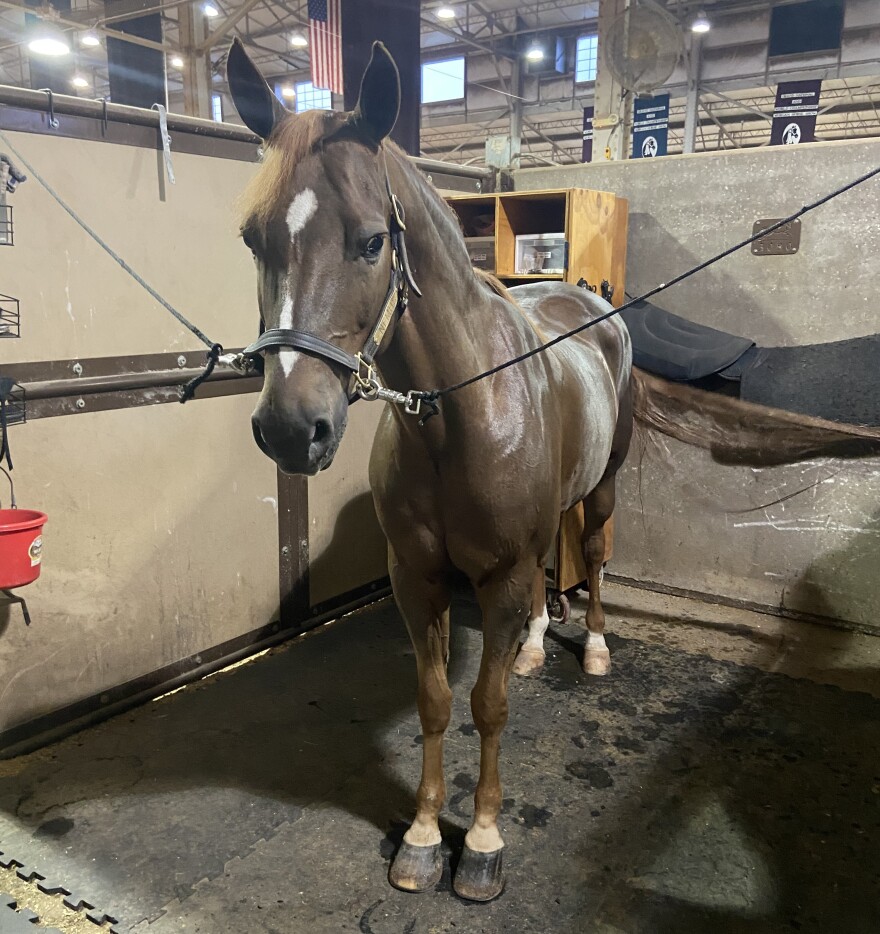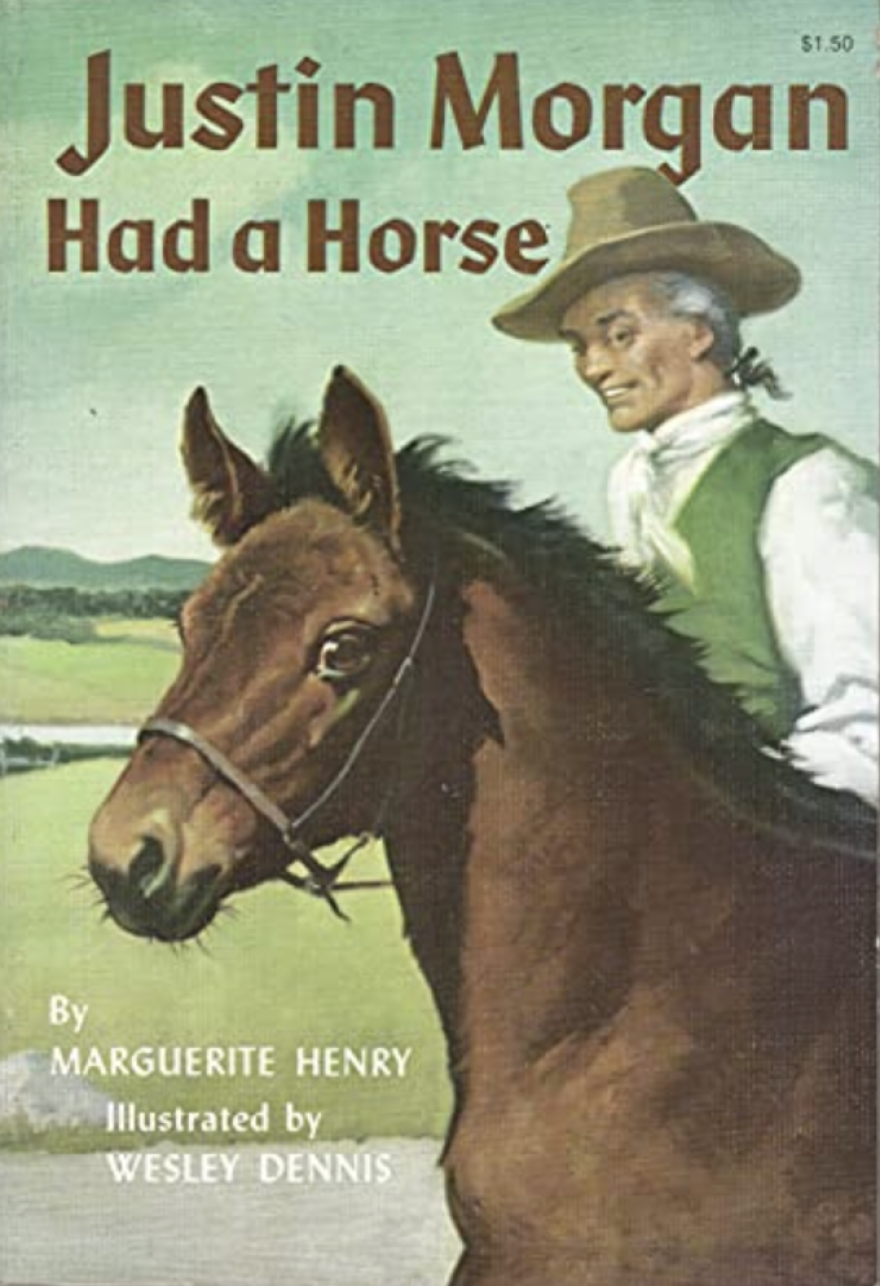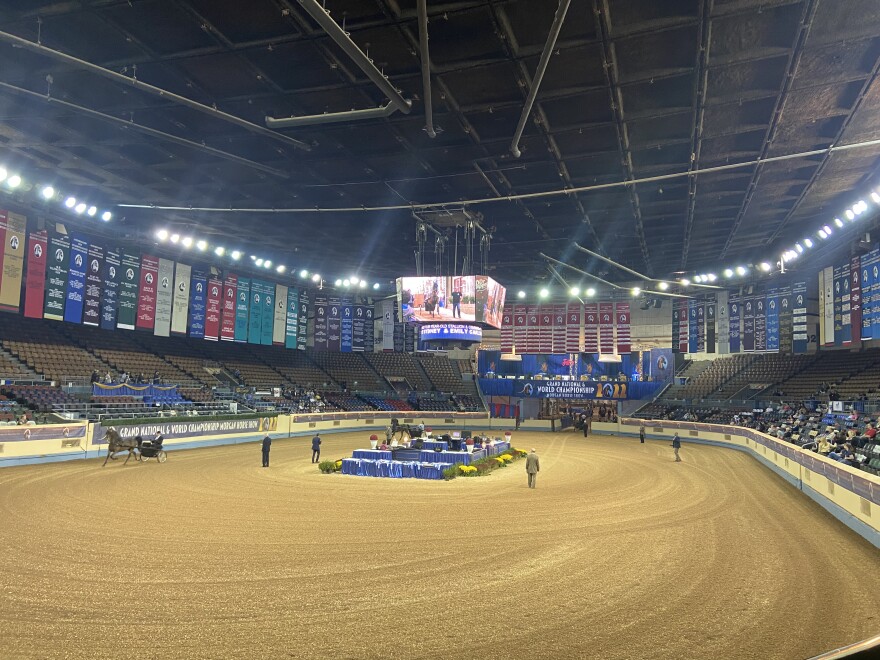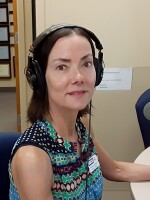HOW CURIOUS EPISODE: Oklahoma and the Morgan Horse
Every year since 1975, the annual Grand National and World Championship Morgan Horse Show has drawn hundreds of horses and thousands of humans to Oklahoma City’s State Fair Park. However, until shortly before I moved to Norman, Oklahoma, in 2022 to join KGOU, I’d never heard of a Morgan horse. Then a friend, learning of my imminent relocation, exclaimed, “my family goes there every year for the Morgan Horse show.” “A Morgan horse, what’s that?” I asked. “It’s one of the first American breeds,” she said. “It’s from Vermont.”
I became intrigued: What was the history of the Morgan horse? What’s so special about it? How does a breed become a breed? And why, if it’s from Vermont, does its biggest show happen in OKC?

That last question Kelly Kraegel was quickly able to put to rest. She’s vice president of the American Morgan Horse Association. She’s also owner of the Cottonwood Creek Ranch Morgan horse facility that’s located only minutes from the show. “I don’t think there’s any better horse facility than our facility here. But it’s also right in the middle of the country so everybody has an opportunity to get here.”
To learn about Morgan horse history, I turned to Amanda Gustin who is Director of Collections and Access at the Vermont Historical Society. She told me that the very first Morgan horse was named Figure, however the breed name comes Figure’s one time owner Justin Morgan. Although little is known about Figure, some facts regarding Justin Morgan’s life are available: “He was born in 1747 in West Springfield, Massachusetts and did a lot of different things in his early life. He initially goes into farming, he also does a little bit of tavern keeping, and he’s a composer, and he also does what is called at the time 'stallioneering'.”
This is where we come to Figure. It appears Morgan acquired him just before he moved to Vermont in 1788 and then quickly started advertising him for breeding. For example, in one ad, Morgan wrote that “the greatest recommend that I can give him is he exceeding sure and gets curious colts”. As Amanda explained, Morgan used the word curious in a slightly different sense to how we normally use it today. What he was effectively saying was this horse is “interesting and exciting. It’s definitely for sure something you want to check out.”
And check him out people did, his descendants too. Kelly Kraegel told me what she finds so special about Morgan horses: “I had been around a lot of different breeds of horses, but once we got that first Morgan – it’s just a totally different kind of horse. To me, their personalities are just a lot more like a dog. They love people, they crave attention.” I commented to her that I had heard that the slogan for Morgan Horses is that “they’re the horse that chooses you” so was that the kind of thing that Kelly was referring to? She agreed enthusiastically: “This is exactly what I’m talking about. They do. I mean the horses in my barn know their owners. They can hear their owner’s voice coming in the barn and you’ll hear their horse nickering and carrying on in the stall, even before I know the owner’s there."
Mallory Mignot, who is originally from France but who is now based at Hallmark Farms in Edmond, Okla., agrees: “They’re beautiful horses. They’re athletic horses, easy to train, fun to train. And versatile. And that’s what I love about them.”
Amanda Gustin confirms the Morgan horse breed reputation for versatility: “It’s historically known as all-purpose breed of horse. They can plow your fields. They can be fancy enough to take you to church. They can be quiet enough for children but exciting enough to show off in a race. They really have an extraordinary capacity for a lot of different things." And these qualities are immediately obvious in the stories that people tell about this first horse. Here’s one of them: For a time while Justin Morgan owned the horse, he leased him to a local man named Robert Evans. And Evans was using this horse to haul away logs and make fields out of forest. And after a long day of work, Evans was bringing Figure back down into town when he came across two huge draft horses pulling a log to the local sawmill, except they weren’t pulling it anymore, they had stopped. They were completely unable to move this huge log any further. And Evans immediately said, “Oh. My horse will take that log the rest of the way, no problem.” No one believed him as it was relatively small horse. So Evans says, “Okay, let’s make it a real challenge. Put a couple of men on it and bet me a gallon of whiskey.” Now everyone’s in it, so men stand on this log. They hitch the Morgan horse up to this log. He gives one heave, it doesn’t move. He gives a second heave and hauls this huge log, that two enormous horses were not able to budge, all the way to the sawmill.

The log challenge story and many others told about Figure through the decades eventually wound up in Marguerite Henry’s Justin Morgan had a Horse. This hugely popular children’s book was first published in 1945 and later turned into a film by Disney. Many of the people I met at the Morgan Horse show told me that they first got into the breed because of Justin Morgan had a horse. The popularity of Marguerite Henry’s enchanting blend of fiction and fact continues today, helping to bring riders as young as two to the event. But although Figure is lauded for building his reputation from scratch, pedigree is going to be central to the establishment of the Morgan Horse breed, though not the only factor.
According to Amanda Gustin: “To have a breed of animal you need a couple of things. You have to have a common set of physical characteristics – in the Morgan horse that is a certain kind of size, a certain kind of stockiness, a certain set of close coupled hind quarters, an upright neck, little short back. And you also have to have a way to keep track of bloodlines. So the Morgan horse registry is actually going to get started with a man named Joseph Battell, and what he really does is obsessively document horses that can trace their lineage back to this first horse and setting up these pedigrees. He’s publishing these lists and lists and lists of horses. Others take up his work, and eventually those early books are incorporated as the stud books of the American Morgan Horse Association.”

That Association was established in 1909. Today, approximately 90,000 horses are registered on its books, about thousand of which regularly convene at Grand National and World Championship Show. It’s a vast event that involves huge amounts of preparation for the horses, for the people involved, and for grounds. As Kelly Kraegel said to me: “The fairgrounds in Oklahoma City are beautiful on their own, but what we all do is build freestanding structures and deck our stalls out. It originally started more for privacy reasons – even though some people might really like to be able to watch in the changing room, none of us ladies appreciate that. Then it just grew over the years because this is such a big deal for us. So if you do come here, you’ll see that there are a lot of elaborate barns. I’ve set my barn up as an old western town and it’s called the Cottonwood Creek Saloon and we have a jail, we have a church, we may or may not have a brothel,” she laughed.
Kelly, who had showed a horse just before I met with her, was also looking pretty fancy: “I have a white cowboy hat on. I have some glorious sparkly earrings. Probably too much makeup. I have a beautiful white leather jacket with some gold lace and some rhinestones on it. My mother passed away probably about six years ago, but she made all of my outfits, so every time I show, I get to ride with a piece of my mum with me, which I love."
Participating in the Morgan Show also prompts fond memories for Mallory Mignot: “My boss, Susan Morey, she was diagnosed with ALS two years ago and I watched her go through that disease and she passed away last December. And she was here showing last year. She couldn’t feel her legs and couldn’t feel her hips. It was the most incredible thing to see that horse take care of her. And she was an incredible show-woman. And through the disease – watching her keeping on fighting, and having the horse really lift her – it was the most beautiful thing.” As my conversation with Mallory came to an end, I asked if she wanted to share any closing thoughts. “Get a Morgan horse,” was her response.
How Curious is a production of KGOU Public Radio. It is produced by Rachel Hopkin and edited by Logan Layden. David Graey composed the theme music.
For this episode, special thanks to Virginia Siegel, Mary Shappey (owner of Majik Stables in Norman), Sarah Duncan, C A Lee III, Kelly McFaul, and Alyssa Plewacki.
Remember, if you have an Oklahoma-related question, email curious@kgou.org.





